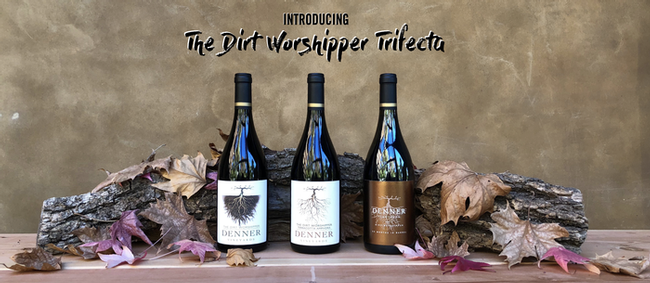
Purchase these wines here!
The Making of
The Dirt Worshipper Trifecta
As I’m sure you know by now, we like to do a fair amount of experimenting in the vineyard and cellar. Sometimes these experiments are so good, we can’t help but bottle them on their own. In 2013, we started an experiment that we just finished four months ago - and after five years of waiting, we can’t wait any longer to share the results with you. Introducing the 2013 Dirt Worshipper Trifecta.
With the fantastic 2013 vintage, we endeavored on an aging vessel trial with the Dirt Worshipper that took us on a journey that was a little unexpected but provided us with 3 very different and delicious wines.
We normally age the Dirt Worshipper in 225L barrels – this is the standard wine barrel size – we feel that this size provides the right amount of oxygen transfer over 20 months to help the wine develop interesting flavors and softer tannins – thus giving it some immediate gratification, but also the ability to improve over 5-10 years of bottle age.
We wanted to see what different sizes, shapes, and mediums would do to the aromatics and texture of the wine. So, in addition to the 225L barrels, we aged some in 500L oak puncheons, some in 320L Cigar shaped barrels with 33mm staves (regular barrels are 27mm thick, so this slows down the rate of oxygenation drastically), and some in a 500L bee’s wax lined terracotta amphora.
In tasting through every barrel when we were getting ready to bottle the 2013 Dirt Worshipper, we noticed dramatic differences in each type of vessel. The regular barrels tasted as we expected, the terracotta provided an increased level of freshness and vibrancy, and the puncheons and cigars seemed a little unresolved and tight on the palate. So, we bottled the regular and amphora-aged wines separately but kept the puncheons and cigars – hammering in the bungs and rolling the barrels onto their sides to keep evaporation to a minimum.
The Dirt Worshipper is a wine that is inspired by the wines of Cote Rotie – the region in the far north of the Rhone valley where they make Syrah and Viognier co-ferments. There are very few wines from Cote Rotie that command the respect of the “La La’s” from Domain Guigal. These are single vineyard wines that are aged for 42 months in new French oak barrels before they are bottled – so I figured that’s what we’d do with these 4 barrels of Dirt Worshipper from 2013 that we didn’t bottle.
At 42 months of aging we rolled the barrel back upright and pried the bungs out of them to taste for the first time in almost 2 years. The results were underwhelming – the wine lacked personality, the textures were flat, and the only real improvement over the original was increased concentration. So, we hammered the bungs back in, rolled the barrels onto their sides, and buried them back in the cellar.
A year later we decided we’d try them again, and this time they didn’t disappoint. The once flat aromas had transformed to vibrant blue fruits and charred meats, the flavors were pronounced yet elegantly evolved, and the texture was like jumping on pillows. We had to bottle it.
These three Dirt Worshippers each offer a different set of strengths:
The original bottling offers the most complete wine: good aromas, polished texture, and a seamless finish – this is a wine that has evolved quite a lot since bottling, but still has years of aging ahead of it.
The Amphora bottling is the most aromatic – offering an incredible display of floral and spice notes – and has remained incredibly fresh and vibrant on the finish, leaving me to believe it will be the longest-lived version of this wine.
The 55 month bottling’s aromas have turned from floral and spicy to blue fruited and meaty, but the texture is really where this wine shines. Offering the most open-knit and approachable set of tannins. It’s really a pleasure to drink right now – and I don’t see it going downhill anytime soon.
Sadly, these wines are very limited in production – with the amphora version coming it at just a little over 50 cases. We feel that this trifecta is best enjoyed as a set so you can experience both the dramatic and subtle differences in these wines – for this reason, we encourage you to purchase these in a 3-pack.
